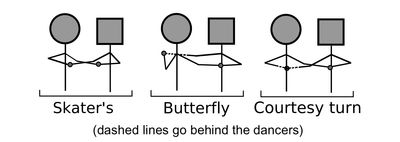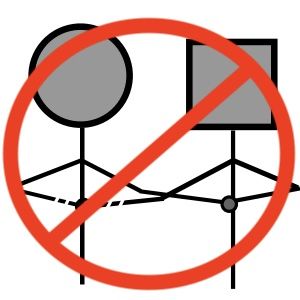Against the Teapot Hold in Contra Dancing
The teapot hold is the most dangerous common contra dancing figure, so I’ve been avoiding it. The teapot hold, sometimes called a "courtesy turn hold,” requires one dancer to connect with their hand behind their back. When I realized I could avoid putting my shoulder into this vulnerable position, my contra dancing felt safer.

In New England, where I dance most often, the teapot hold is used both for the courtesy turn, where the couple rotates to face the opposite direction, and also the promenade, where the couple walks forward. Elsewhere, promenade might default to skater’s or butterfly[1].
Why I don’t like the Teapot Hold
It puts your shoulder in an unsupported position
There’s no way to guarantee you won’t get injured while social dancing, but you can usually minimize the risk. However, the teapot hold prevents you from protecting yourself, because placing your hand behind your back twists your shoulder out of its stable position in its socket. This puts your shoulder in a vulnerable position, mostly supported by connective tissue rather than muscle, and therefore less able to stabilize and shock absorb unexpected forces. If the other dancer tugs on your arm, there’s not a lot you can do. Skater’s hold is safer because holding both arms in front keeps your shoulder supported and dynamic, able to absorb an unexpected push or tug.
It requires significant shoulder mobility
Many dancers – especially older dancers and dancers with shoulder injuries – cannot rotate their shoulder enough to reach the small of their back[2]. I often notice dancers who cannot get into the position for a courtesy turn or promenade during beginner workshops. Contra’s intergenerational nature is important to me. I don’t like that one of the basic figures requires a range of motion that older adults commonly lose.
It invites connection near the small of the back
The small of the back is an intimate location. There are people I’m comfortable placing their hand on my shoulderblade, who I would not want feeling my lower back. In theory, the teapot hold is hand-to-hand, but I’ve frequently had someone reach for my hand and miss, even though I currently have full range of motion. It probably happens even more for folks who struggle to put their hand there. Ideally, upon not catching the hand would float behind the back, unconnected, but in reality, unwanted lower back touches do happen.
Replacing the Teapot Hold
I’ve spent the last few months avoiding the teapot hold, offering skater’s during promenades and courtesy turns, and it’s gone really well.
In teapot hold, the most important connection point is the hands in front. That connection is unchanged when switching to skater’s - the hands in front are in the same place as before. Because this is the most crucial connection mechanically, where weight is primarily shared, the location of the secondary hands is less impactful on the success of the overall figure. If it connects, great! If it doesn’t, no biggie, you are still dancing. And in my experience, offering skater’s clearly in front usually connects just fine.
Occasionally, it doesn’t go perfectly. Sometimes people don’t notice, so we connect one-handed and continue dancing. In one case, a person was confused thinking I was offering a twirl they didn’t recognize. But most of the time, it just works. Both experienced and new dancers roll with the difference just fine. New dancers are a bit overwhelmed with so many new-to-them things on the floor, so one more thing isn’t a big deal - they’re already primarily reacting in the moment anyways. An offer of holding hands is clear and they connect in the obvious way without issue. More experienced dancers are used to following the unexpected, and have often seen skater’s hold before, so adjust easily.
I was worried at first that always offering skater’s would mean more lower back touches, as people put their hand there out of habit and my hand wouldn’t be able to catch theirs. In practice, this hasn’t been the case; if anything it has slightly decreased because I’m so clearly inviting connection in front instead.
The small handful of briefly confused folks feels worth it to avoid dancing with my shoulder in a vulnerable position. I hope to continue dancing for many years to come, and making small changes to reduce my chance of injury on the floor helps make the odds of that higher.

Promenade Positions Image from Jeff Kaufman’s blog post on differences in contra dancing across the country ↩︎
Pike JM, Singh SK, Barfield WR, Schoch B, Friedman RJ, Eichinger JK. Impact of age on shoulder mobility and strength. JSES Int. 2022 Sep 14;6(6):1029-1033. doi: 10.1016/j.jseint.2022.08.016. PMID: 36353423; PMCID: PMC9637716. ↩︎